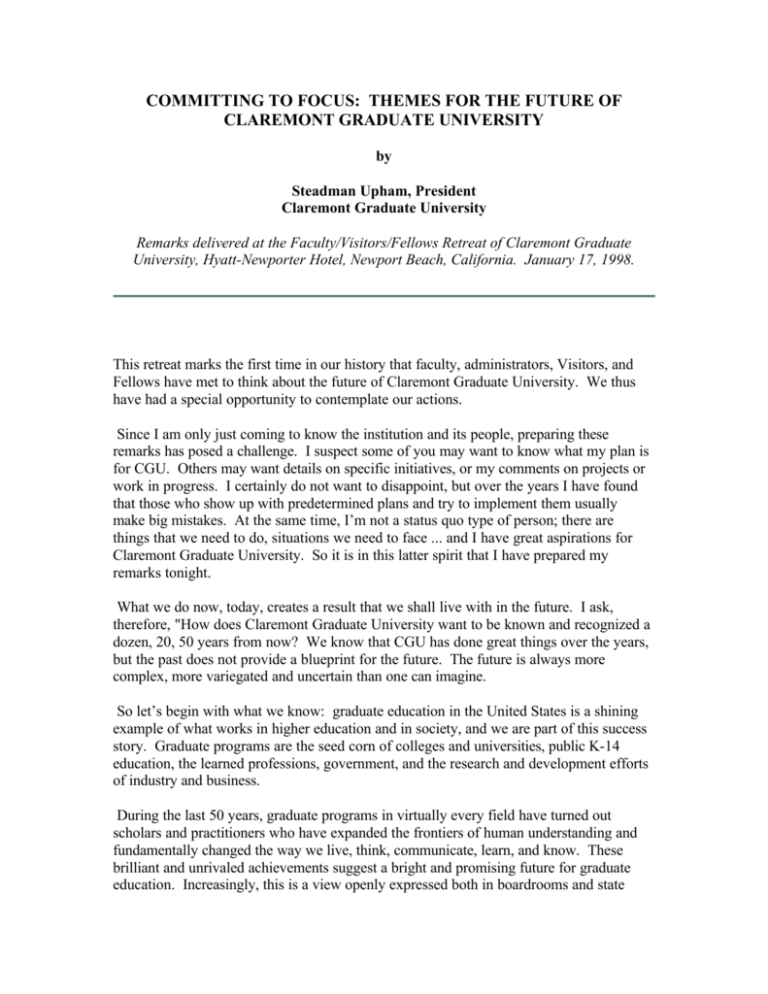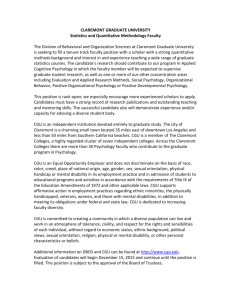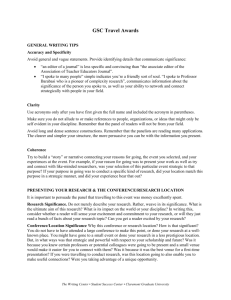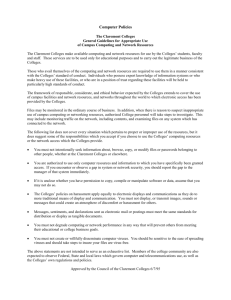committing to focus: themes for the future of claremont graduate
advertisement

COMMITTING TO FOCUS: THEMES FOR THE FUTURE OF CLAREMONT GRADUATE UNIVERSITY by Steadman Upham, President Claremont Graduate University Remarks delivered at the Faculty/Visitors/Fellows Retreat of Claremont Graduate University, Hyatt-Newporter Hotel, Newport Beach, California. January 17, 1998. This retreat marks the first time in our history that faculty, administrators, Visitors, and Fellows have met to think about the future of Claremont Graduate University. We thus have had a special opportunity to contemplate our actions. Since I am only just coming to know the institution and its people, preparing these remarks has posed a challenge. I suspect some of you may want to know what my plan is for CGU. Others may want details on specific initiatives, or my comments on projects or work in progress. I certainly do not want to disappoint, but over the years I have found that those who show up with predetermined plans and try to implement them usually make big mistakes. At the same time, I’m not a status quo type of person; there are things that we need to do, situations we need to face ... and I have great aspirations for Claremont Graduate University. So it is in this latter spirit that I have prepared my remarks tonight. What we do now, today, creates a result that we shall live with in the future. I ask, therefore, "How does Claremont Graduate University want to be known and recognized a dozen, 20, 50 years from now? We know that CGU has done great things over the years, but the past does not provide a blueprint for the future. The future is always more complex, more variegated and uncertain than one can imagine. So let’s begin with what we know: graduate education in the United States is a shining example of what works in higher education and in society, and we are part of this success story. Graduate programs are the seed corn of colleges and universities, public K-14 education, the learned professions, government, and the research and development efforts of industry and business. During the last 50 years, graduate programs in virtually every field have turned out scholars and practitioners who have expanded the frontiers of human understanding and fundamentally changed the way we live, think, communicate, learn, and know. These brilliant and unrivaled achievements suggest a bright and promising future for graduate education. Increasingly, this is a view openly expressed both in boardrooms and state legislatures around the country. In fact, there is a growing recognition in America that an individual’s total years of education are positively correlated with income potential and with every index of social well being that psychologists have devised. Graduate degree holders are not at risk on America’s landscape of the future; they are distinctly "at promise." In many American households, there are growing aspirations and expectations that each child will receive a college education. Last year’s national discourse on higher education highlighted all of the tangible and intangible benefits of college attendance, and helped to institutionalize further the pursuit of a college degree in the American mind. We thus now see the leading edge of a wave of baccalaureate-seekers headed to college. As this wave of new students passes through four-year colleges and universities, more and more Americans will also be seeking graduate degrees. Some human resources specialists even predict that the master’s degree will become an entry-level credential that is expected by employers in many different sectors of the economy. Finally, working professionals ... the quintessential nontraditional students ... are recognizing in increasing numbers that their career advancement depends on continuing training and education. Executive certification and lifelong learning thus represent yet another dimension of the growing demand for graduate education. Such demand has created a robust economy around post-baccalaureate instruction. New educational providers, including some whose stocks are publicly traded (e.g. the Apollo Group), rush to capture market share in graduate and professional education. In California, which is perhaps the richest and most diverse educational market in the world, the situation is even more complex both because of the large number of public institutions which offer graduate programs, and the emergence of "corporate universities" which offer in-house training and education. This is the future we confront. It is a future laden with opportunity, but also one that is filled with competitive risk and uncertainty. In this highly competitive environment, the niche occupied by an educational institution, the institution’s "signature focus," and consumers’ choice become especially relevant. Where, then, does Claremont Graduate University fit on this educational landscape? What is CGU’s signature focus? How can CGU position itself to grow, develop, indeed, to flourish on this landscape of the future? In my view, there are at least four major themes on which CGU must concentrate to refine its signature focus and secure its educational niche: 1) CGU must be a national university, 2) CGU must maintain its historic commitment to uncompromising academic quality, 3) CGU must reemphasize interdisciplinary scholarship, research, and teaching, and 4) CGU must transform itself financially to survive. These themes are not new to this academic community. Indeed, each has been identified previously in reports, plans, and other documents during the last decade. What makes our current context different, however, is that we must move on with strategic planning. These themes now must guide our strategic "achieving," and must command the full force of our collective commitment and focus. I. CGU Must Be A National University In 1997, the Board of Fellows acted to change the name of our institution to Claremont Graduate University. I want to say clearly tonight that I endorse this change, and would have supported it in the Board of Fellows had I been present when the vote was taken. It represents a bold step into the future, and defines a direction for the institution that is quite different from its previous course. Changing our name to Claremont Graduate University is much more than a semantic alteration, much more than a new logo and reprinting of the letterhead. The word university denotes a structure and a purpose. It signals a fundamental change in the aspirations and goals of the institution, and carries with it the expectations of excellence borne of historical traditions in academe that go back to at least A.D. 1300. In structure, the academic core of every great university is the liberal arts. I use the term "liberal arts" purposefully to affirm the fundamental intellectual link back to the trivium and quadrivium. At CGU, our liberal arts core is defined by advanced study in the humanities and social sciences (our trivium), and art, music, and selected sciences (our quadrivium). Moreover, CGU’s liberal arts core is fused with and synergized by outstanding professional programs in education, management, and information science. This union of liberal arts and professional programs is a hallmark of the contemporary university, and must continue to be one of the signal strengths and defining characteristics of Claremont Graduate University. In purpose, a university is founded upon and thrives within the doctrine of wholeness; that is, it covers an intellectual universe of inquiry. Consequently, as a graduate university, we foreclose no options in developing or expanding disciplinary foci, including new professional programs or new programs in the basic and applied sciences, especially if their development or acquisition strengthens our existing liberal arts and professional degrees. I make this point to underscore my commitment to the idea of the university, and to give meaning and substance to the act that created a university within the Claremont consortium. But CGU cannot just be a university; it must be a national university. CGU’s local context is the Claremont consortium and the many communities of Southern California. It is a given that we must be energetically and constructively engaged in these communities. We draw many students and friends to CGU from them, and have partners in business, government, and education throughout the region, but the defining context for CGU in the next decade must be expanded. If we are to realize the dream of building a truly exceptional graduate university, it must be national and international in scope and mission, drawing to it the most accomplished faculty, the most talented students, and the most dedicated and engaged Fellows, Visitors, and friends wherever they are to be found. I note with enthusiasm and appreciation that we have an extraordinary foundation already in place from which to build. This goal of building a national university brings me back to the name change of 1997. Along with the transformations I have just described, we must also launch a wellplanned, well-financed marketing campaign to let the world know that Claremont Graduate University is aggressively pursing its mission as a national university of consequence and distinction with an historical commitment to outreach, practice, and civic engagement. I shall have more to say about this effort in the coming months, and I will be consulting with many of you to gain the benefit of your insights and expertise on this matter. II. CGU Must Maintain its Historic Commitment to Uncompromising Academic Quality The schools of the Claremont consortium are known throughout the world for their commitment to the highest quality academic programs, and for their intellectual nurturing of students. Claremont Graduate University must continue to make this tradition of student-centered education the focus of all of its activities. Thoughtful and committed student-centered teaching and learning distinguish us from many other providers of graduate education. There is no substitute for this commitment to the student-centered model of graduate education. Faculty are the key to successful student-centered education. In a very real sense, faculty are the institution. The academic credentials and accomplishments of the faculty define the field on which the institution plays. Faculty are largely responsible for developing programs that meet the needs of society, for attracting the best and brightest students, and for creating the intellectual environment in which scholarship and creative activity flourish. Our greatest challenge now and in the future will be to hire and retain faculty who allow us to realize the full promise of CGU. We must find ways to ensure that all of our faculty ... now and in the future ... feel personally and professionally motivated to be fully engaged with our enterprise. I view this as one of my highest priorities as president. Moreover, when we hire new faculty, we shall do so only if they improve the reputation and position of the institution. If we abide by this simple principle, CGU will continue to grow in stature and reputation with each replacement or addition to the faculty. Abiding by this principle, however, will test our resolve and our resource base, and may mean that we will hire fewer but better faculty over the next decade. For my part, I pledge to honor CGU’s governance structures. The best universities are those with strong traditions of faculty governance and Board oversight, in which planning and decision-making are shared, and discussion -- even disagreement -- can occur in an atmosphere of trust, mutual respect, civility, and collegiality. These are the kinds of places in which we all want to work and to which we all want to dedicate ourselves. III. CGU Must Reemphasize Interdisciplinary Scholarship, Research, and Teaching As a small, graduate-only university, CGU’s uncompromising commitment to academic quality defines one aspect of its signature focus. Another key aspect pertains to the content of CGU’s degree programs. The small size of the faculty requires that we communicate and collaborate across the sometimes arbitrary boundaries of academic disciplines, and from the liberal arts to professional programs. CGU’s strength must continue to emanate from interdisciplinary research, scholarship, and teaching. Being an interdisciplinary university is not a weakness. On the contrary, many of the most exciting ideas and applications are found at the intersections of the scholarly disciplines. But we cannot expect that interdisciplinary collaborations will happen simply because we are small. We all must actively work together to ensure that meaningful interdisciplinary scholarship and teaching remain a primary objective of the institution. The spirit and reality of interdisciplinary teaching and research begin at home, but we also have an obligation to advance such collaborations within the Claremont consortium. Graduate faculty have a responsibility to be academic leaders within the consortium. Academic programs are enriched beyond measure when the roster of faculty expertise is broadened and deepened. I anticipate that every one of CGU’s academic programs will be continuously and vigorously enriched through such activity. I also recognize that my vision of CGU as a truly interdisciplinary learning environment can only be achieved through functioning program committees, active plenary faculties, and dedicated faculty lines that carry real expectations for cross-college involvement. Helping to facilitate such collaborations within the consortium is one of my primary goals, and I will work closely with the other presidents and with the Board of Fellows to create incentives for this agenda. IV. CGU Must Transform Itself Financially to Survive Finally tonight, I want to talk about transformations. CGU has reached a point in its history where it must address directly its long-term financial and academic health. Tuition is currently at or above the national market for graduate education, and the institution is much too dependent on tuition dollars to meet annual operating expenses. The institutional cost of facilities, instructional technology, faculty and staff salaries, student financial support, supplies and equipment, and all of the other elements that combine to make high quality graduate education will continue to increase as far into the future as we can see. CGU cannot continue to raise tuition to meet these rising incremental costs. Of course, what I have just said has been recognized for some time by the present CGU administration and by the Board of Fellows. The "Guidelines for CGU’s Fourth Phase" prepared by the Strategic Planning Committee in 1989 made these same observations. Our current capital campaign is designed, in part, to address these long-term financial problems. But even with completion of the $50 million capital campaign, many of these financial dilemmas will persist, posing a serious impediment to academic improvement. And this recognition goes to the heart of the matter: high quality graduate education is expensive. It is done in small-group settings, requires state-of-the-art facilities and equipment, is not easily streamlined, and is labor intensive. Today, the high cost of graduate instruction is forcing the best research universities in America to subsidize graduate education with the tuition dollars of undergraduates. CGU does not have undergraduates, and so bears the real cost of graduate-level instruction directly and fully on its own operating budget. For this reason, high quality graduate-only institutions like CGU are still an experiment in progress in American higher education. Although there are tantalizing indications of a positive result, the outcome of the experiment is not yet completely clear. CGU must build a secure financial base over the next decade for our experiment to succeed. We are thus in control of our own destiny. A stable financial future will require transforming actions by every CGU constituency. All of us will need to find ways to stretch our current and future commitments and to renew our dedication to Claremont Graduate University. In the coming years, transforming gifts and grants will be required in at least four areas: 1. Each academic school and center at CGU needs to be identified by a donor’s name and supported by a corresponding cornerstone endowment. The cornerstone endowment provides a foundation for true academic excellence at the national level, and is the key to long-term financial stability for each unit. 2. We must secure support for clusters of endowed chairs, like the 30 William Rand Kenan Professorships at University of North Carolina or the 20 Philip A. Knight Chairs at University of Oregon. Such gifts are transforming these institutions from second-tier universities to elite members of the AAU. A named cluster of endowed chairs at CGU can be the centerpiece of our commitment to focus. 3. We must endow dozens of student fellowships to make sure we compete successfully for the very best graduate students in the world. Research universities are our competition in this arena, and CGU must be able to offer sufficient financial aid to compete with them head-to-head for the most talented students in the disciplines we offer. 4. CGU’s physical plant must keep pace with the demands for excellence that we place on our academic programs. We shall need new and renovated buildings, enhancements to technology, and expanded central support for computing and libraries to realize our goals. Because of the solid foundation upon which we build, Claremont Graduate University is ideally positioned to become the model of high quality graduate education in the United States. Although the future is uncertain and filled with competitive challenges, I would not be standing before you tonight if I had a moment’s doubt about the outcome of our experiment. We thus begin our next phase with steadfast commitments to academic quality, to interdisciplinary scholarship and teaching, and to our new context as the graduate university in Claremont. Finding our way will require the engagement and transforming actions of every CGU constituency. It is my great privilege and distinct honor to join you as we face our future and complete this extraordinary experiment.




